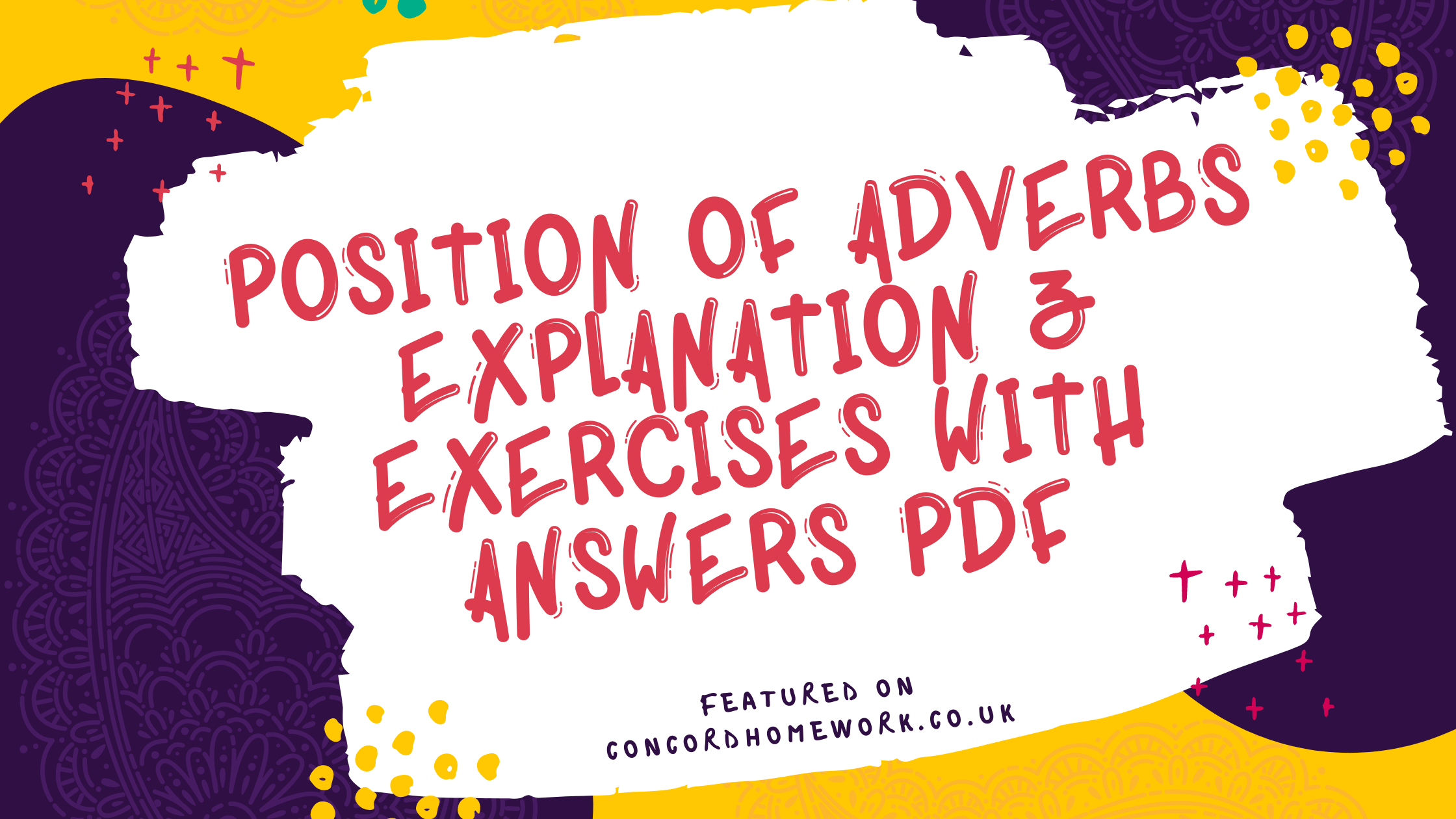Adverbs/Adverb phrases of Time, Place and Manner
There are three main positions for adverbs which modify a verb:
| Position | Example |
|---|---|
| front position = before the subject | • Finally he could stand the noise no longer. |
| mid position -~ between the subject and verb, or immediately after be as a main verb | • He usually plays better than this. • She’s usually here by 10.00. |
| end position = after the verb | • We’ve been waiting for hours. |
Most types of adverb can go in front position. For example:
| type of adverb | function | example |
|---|---|---|
| connecting adverbs e.g. as a result, similarly | …to make immediately clear the logical relation to the previous sentence | The value of the yen has fallen. As a result, Japan faces a crisis. |
| time and place adverbs e.g. tomorrow, in the kitchen | …to show a contrast with, or expansion on, a previous reference to time or place | The last few days have been hot. Tomorrow the weather will be much cooler. |
| comment and viewpoint adverbs e.g. presumably, financially | …to highlight the speaker’s attitude to what they are about to say | • She has just heard that her sister is ill. Presumably, she will want to go home. |
The following types of adverb usually go in mid position: adverbs of indefinite frequency e.g. always, never, usually; degree adverbs e.g. completely, quite, and focus adverbs e.g. just, even:
• He always sings when he’s having a shower.
• I completely forgot her birthday, and I just don’t know how to make it up to her.
Most adverbs of time or place don’t go in this position:
Amy had a baby in October. (not Amy in October had a baby.)
However, a few often do, including already, finally, now, recently, soon, still:I finally met Mark at the conference in Istanbul.
and in journalism, other adverbs of time are often used in mid position:The government yesterday announced an increase in education spending.
In mid-position, we put adverbs where we would put not, or after it if not is already there:Claire’s never at home these days, (compare ‘Claire isn’t at home…’) I don’t fully understand.
It has seldom been seen here before. (compare ‘It hasn’t been seen…’)
In end position, we usually put an adverb after an object or complement if there is one:He studied the problem briefly, (not He studied briefly the problem.)
However, if an object or complement is very long, then we often put an adverb between the verb and its object or complement. This is particularly common in journalism:We considered briefly the long-term solution to the problem.
When there is more than one adverb in end position, the usual order in written English is adverb of manner (= saying how something is done), place, and then time:In the accident she was thrown violently against the door. (= manner + place)
However, if one adverb is much longer than another then it is usually placed last:They left at 3.00 with a great deal of noise. (= time + manner)
Adverbs of place
Adverbs of place usually go in end position, but we can put them in front position to show a contrast or expansion. This order is found mainly in descriptive writing and reports. Compare:
The money was eventually found under the floorboards. (= end) and
The police searched the house and under the floorboards they found a body. {= front)
If we put an adverb of place in front position we have to put the subject after the verb be:Next to the bookshelf was (not Next to the bookshelf a fireplace was.)
We can also do this with intransitive verbs used to indicate position or movement to a position, including hang, lie, live, sit, stand; come, fly, go, march, roll, run, swim, walk:Beyond the houses lay (rather than …open fields lay.)
Through the town square marched the band. (rather than …the band marched.)
However, we don’t do this if one of these intransitive verbs is followed by an adverb of manner, with other intransitive verbs, or with transitive verbs:Above his head the sword hung menacingly, (not …hung the sword menacingly.)
Outside the church the choir sang. (not …sang the choir.)
In the garden John built a play house for the children, (not In the garden built John…)
Adverbs of indefinite frequency
Some adverbs of indefinite frequency, which say in an indefinite way how often something happens, usually go in mid-position. These include hardly ever, often, rarely, regularly, seldom, and also never and always.
She regularly comes home after midnight.
Other adverbs of indefinite frequency, such as normally, occasionally, sometimes, and usually, can also go in front or end position:I normally (= mid) get up at six o’clock, but sometimes (= front) I have to be up by five.
In formal, literary English, adverbs of indefinite frequency which have a negative meaning can go in front position. The subject must come after an auxiliary verb or a main verb be in sentences like this:Never had we encountered such an unreasonable official 1, (not Never we had encountered…)
Not once was he at home when I phoned. (not Not once he was…)
- Other adverbs like this include hardly ever, rarely, seldom, and also at no time.
If there is no auxiliary verb, we use do. Compare:
He never admitted that his team played badly. At no time did he admit that his team played badly. (not At no time he admitted…)
Adverbs of time
Adverbs of time, which indicate a definite point or period in time or a definite frequency, usually go in front or end position, but not in mid position:
• I went to Paris yesterday. or • Yesterday I went to Paris.
. We play tennis twice a week. or • Twice a week we play tennis.
However, the adverbs daily, hourly, monthly, weekly, etc. only go in end position:
The train leaves Penn station hourly (not Hourly the train leaves…; not The train hourly leaves…)
Download “Position of adverbs Explanation” in pdf.
Download “Position of adverbs exercises with answers” in pdf.
Source: Hewings Martin, Advanced Grammar in Use. Cambridge University Press.
“Thank you for taking the time to explore this topic with us! We hope you found the information helpful and insightful. Have any thoughts, questions, or additional examples to share? We’d love to hear from you in the comments below!
Don’t forget to spread the word by sharing this blog with your friends, family, and colleagues. Together, let’s continue to learn, grow, and connect with the world around us. Happy reading and sharing!”




















